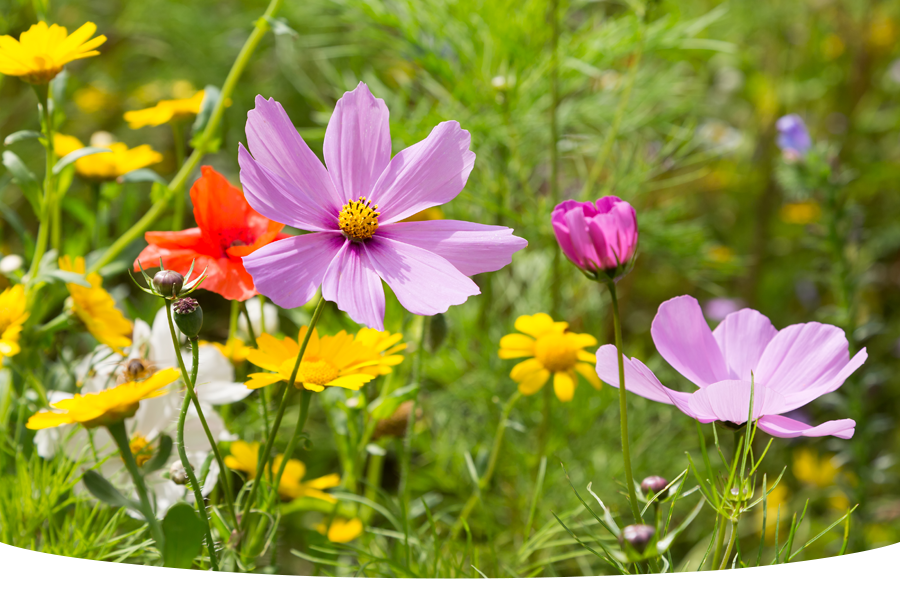8 great reasons to sow wildflowers
If you’re on the fence about sowing wildflowers and agonising over adding them to your garden, we have eight great reasons to convince you why sowing wildflowers is one of the best things you can do!

1) They provide a greater variety of flora
Most garden flora contains one type of species, whereas if you sow wildflowers, a wildflower mix contains many different types of wildflowers. This means a selection of annual and perennial wildflowers that can pop up at different times, making sure your meadow has blooms throughout Spring and Summer.
This also means you’ll have a full spectrum of colour in one spot – from the red, whites and blues of Cornfield annuals to the bright and light pinks of Coneflower and Musk Mallow. So, if you want to be continually surprised and amazed by your garden flora, you should definitely consider sowing a wildflower meadow- and our How to sow wildflowers guide will help you achieve this!
2) Wildflowers are longer lasting
Typically, most garden flora has a very short flowering period – for example, a peony will only bloom for up to 10 days, whereas wildflowers can bloom over multiple months. Wildflower species have different flowering periods, but most will stay in bloom for up to 2 months. That’s uninterrupted colour all summer long!
3) They attract bees and pollinators
Bees, butterflies and lots of other insects adore wildflowers. Their bevy of blooms, sweet smell and inviting bright colours make them a hotspot for pollinators. You can help support your local pollinators by sowing wild areas in your garden and enjoy the hive of activity as they buzz and flutter in between your flowers. Our Bees Please and Hi Butterfly seed mixes are perfect for attracting more pollinators to your garden.
4) Sow wildflowers to make good use of hard to grow areas
You might find that some areas of your garden make it hard to grow anything. For example, shaded areas where nothing seems to take and clay soils that are difficult to work with. Well, wildflowers, unruly as they are, will grow just about anywhere! There are also wildflower species that are especially good at growing in shaded or clay soil conditions. So, if you have an empty area that never gets much use, wildflowers should be at the top of your list to try!
5) They provide a habitat to help support local wildlife
Lots of blooms in your garden are wonderful, but when it comes to winter, and they’ve died down and you’re left with an empty bed or border, it can be disappointing. When you sow a wildflower mix that contains grass, the grasses will stay behind when the flowers begin to die off. These long meadow grasses still make a pretty feature and can also host a home for wildlife such as hedgehogs, so you can do your bit for the environment all year round!
6) Wildflowers are low maintenance
With other garden flora, you may find yourself pruning and preening, feeding, and whispering sweet nothings to keep your flowers in good nick. Wildflowers prefer a bit of tough love, so you don’t need to feed them to keep them looking their best or use any fancy topsoil!
They also don’t need to be watered regularly to help them grow – so you can let our UK weather take care of that. Other garden flora may require sunnier spots or certain PH levels to thrive, but wildflowers will happily grow in whatever you provide them with. Now, there’s fuss-free gardening you can boast about!
7) They only require a little prep work
Sowing wildflowers is easy - Pick a spot, strip the area back to bare soil, sow the seed at 5g per m2 and rake in. And that's all there is to it since nature does most of the watering for you! They are also easy to maintain year on year.
At the end of the blooming season (typically the end of August or the beginning of September), when the flowers have gone dry and crisp, you can cut your meadow down to 7cm using garden shears or a strimmer. Remove the green clippings/material and firm the seedheads into the soil to get your wildflowers to come back. You can also easily seed save.
8) A wildflower meadow doesn't cost much to grow
Due to wildflowers being low maintenance, you can save money on pruning tools, top soil and plant food. The only cost you’ll have is purchasing the seeds in the first place, and they’ll come back year after year for you!
As if these aren’t reason enough to try wildflowers in your garden, we also make it easy to decide what mix to choose and how much you’ll need – alongside our helpful step by step video guides.



